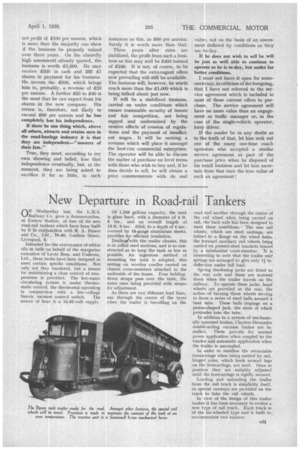New Departure in Road-rail Tankers
Page 45

If you've noticed an error in this article please click here to report it so we can fix it.
f-IN Wednesday last, the L.M.S. ‘.../Railway Co. gave a demonstration, at Euston Station, of two of its new road-rail tankers which have been built by it in conjunction with R. A. Dyson and Co., Ltd., 76-80, Grafton Street, Liverpool, 8.
Intended for the conveyance of edible oils in bulk on behalf of the margarine executive of Lever Bros. and Unilever. Ltd., these tanks have been designed to meet certain specific conditions. Not only are they insulated, hut a means for Maintaining a close control of temperature is provided. The hot-water circulating system is under thermostatic control, the thermostat operating in conjunction with a low-voltage Sunvic vacuum control switch. The source of heat is a 24-32-volt supply.
Of 1,250 gallons capacity, the tank is glass lined, with a diameter of 4 ft. 6 ins., and an overall length of 13 ft. 9 ins. Affol, to a depth of 4 ins., covered by 18-gauge aluminium sheets, provides for efficient insulation. Dealing/with the trailer chassis, this is in rolled steel sections, and is so constructed as to keep the tank as low as possible. An ingenious method of mounting the tank is adopted, this resting on wooden cradles carried on chassis cross-members attached to the underside of the frame. Four holding. down straps pass over the tank, the outer ones being provided with means for adjustment.
As there are two different load lines, one through the centre of the tyres when the trailer is travelling on the
road and another through the centre of the rail wheel when being carried on rail, the back axle has been designed to meet these conditions.The rear rail wheels, which are steel castings, are bolted to a flange on the wheel hubs, the forward auxiliary rail wheels being carried on pressed-steel brackets braced by a substantial cross-member. it is interesting to note that the trailer rear springs are arranged to give only 11 in,
deflection under full load. •
Spring deadening jacks are fitted to the rear axle and these are screwed down when the trailer travels on the railway. To operate these jacks, hand wheels are provided at the rear, the action of turning those wheels serving to force a series of steel balls around a bent tube. These • balls impinge on a piston-shaped jack, the stem of which . protrudes into the tube.
In addition to a system of mechanically operated brakes. Clayton-Dewandre double-acting vacuum brakes are installed. These provide for normal power application when coupled to the tractor and automatic application when the trailer is uncoupled.
In order to stabilize the retractable • forecarriage when being carried by rail, hinged arms, which hook around lugs on the forecarriage, are used. Once in position they are suitably adjusted until the forecarriage is rigidly secured,
Loading and unloading the trailer from the rail truck is simplicity itself, as special rnnways are provided on the truck to take the rail wheels.
In view of the design of this trailer tanker it has been necessary to evolve a new type of rail truck. Each truck is of the six-wheeled type and is built to, accommodate two tankers




























































































